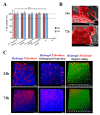Hydrogel Dressings for the Treatment of Burn Wounds: An Up-To-Date Overview
- PMID: 32630503
- PMCID: PMC7345019
- DOI: 10.3390/ma13122853
Hydrogel Dressings for the Treatment of Burn Wounds: An Up-To-Date Overview
Abstract
Globally, the fourth most prevalent devastating form of trauma are burn injuries. Ideal burn wound dressings are fundamental to facilitate the wound healing process and decrease pain in lower time intervals. Conventional dry dressing treatments, such as those using absorbent gauze and/or absorbent cotton, possess limited therapeutic effects and require repeated dressing changes, which further aggravate patients' suffering. Contrariwise, hydrogels represent a promising alternative to improve healing by assuring a moisture balance at the burn site. Most studies consider hydrogels as ideal candidate materials for the synthesis of wound dressings because they exhibit a three-dimensional (3D) structure, which mimics the natural extracellular matrix (ECM) of skin in regard to the high-water amount, which assures a moist environment to the wound. There is a wide variety of polymers that have been used, either alone or blended, for the fabrication of hydrogels designed for biomedical applications focusing on treating burn injuries. The aim of this paper is to provide an up-to-date overview of hydrogels applied in burn wound dressings.
Keywords: burn injury; hydrogels; skin regeneration; wound dressing; wound healing.
Conflict of interest statement
The authors declare no conflict of interest.
Figures






References
-
- Koehler J., Brandl F.P., Goepferich A.M. Hydrogel wound dressings for bioactive treatment of acute and chronic wounds. Eur. Polym. J. 2018;100:1–11. doi: 10.1016/j.eurpolymj.2017.12.046. - DOI
-
- Jeschke M.G., Gauglitz G.G. Pathophysiology of Burn Injuries. In: Jeschke M.G., Kamolz L.-P., Sjöberg F., Wolf S.E., editors. Handbook of Burns Volume 1. Springer; Berlin/Heidelberg, Germany: 2020. pp. 229–245.
Publication types
LinkOut - more resources
Full Text Sources
Other Literature Sources

